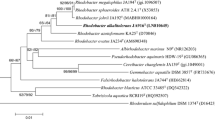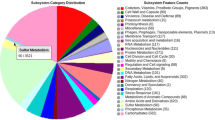Abstract
Rhodococcus spp. (Eu-32) has the unique ability to metabolize organic sulphur containing compounds like dibenzothiophene through an extended sulphur specific pathway (Akhtar et al., in FEMS Microbiol Lett 301:95–102, 2009). Efforts were made to isolate and characterize the presumed desulphurizing genes (dszABC) involved in the sulphur specific pathway of isolate Eu-32 by employing standard and degenerate polymerase chain reaction primers. The partial dszA gene sequence of isolate Eu-32 showed 92 % sequence identity with a putative FMNH-2 dependent monooxygenase of Rhodococcus erythropolis PR4. The dszC gene sequence showed 99 % homology with the dibenzothiophene monooxygenase desulphurizing enzyme of another Rhodococcus species. The dszB gene was not unambiguously identified. A phylogenetic analysis by maximum likelihood method of the 16S rRNA gene and deduced DszA and C amino acid sequences suggest that horizontal gene transfer events might have taken place during the evolution of desulphurizing genes of Rhodococcus spp. (Eu-32).





Similar content being viewed by others
References
Akhtar N, Ghauri MA, Anwar MA, Akhtar K (2009) Analysis of the dibenzothiophene metabolic pathway in a newly isolated Rhodococcus spp. FEMS Microbiol Lett 301:95–102
Alves L, Melo M, Mendonca D, Simoes F, Matos J, Tenreiro R, Girio FM (2007) Sequencing, cloning and expression of the dsz genes required for dibenzothiophene sulfone desulfurization from Gordonia alkanivorans strain 1B. Enzyme Microb Technol 40:1598–1603
Anisimova M, Liberles DA, Philippe H, Provan J, Pupko T, Haeseler A (2013) State-of the art methodologies dictate new standards for phylogenetic analysis. BMC Evol Biol 13:161–169
Arensdorf JJ, Loomis AK, DiGrazia PM, Monticello DJ, Pienkos PT (2002) Chemostat approach for the directed evolution of biodesulfurization gain-of-function mutants. Appl Environ Microbiol 68:691–698
Ausubel FM, Brent R, Kingston RE, Moore DD, Seidman JG, Smith JA, Struhl K (1995) Short protocols in molecular biology, 3rd edn. Wiley, New York
Blanc V, Lagneaux D, Didier P, Gil P, Lacroix P, Crouzet J (1995) Cloning and analysis of structural genes from Streptomyces pristinaespiralis encoding enzymes involved in the conversion of pristinamycin-IIB to pristinamycin-IIA (PIIA): PIIA synthase and NADH: riboflavin 5′-phosphate oxidoreductase. J Bacteriol 177:5206–5214
DenisLarose C, Labbe D, Bergeron H, Jones AM, Greer CW, AlHawari J, Grossman MJ, Sankey BM, Lau PCK (1997) Conservation of plasmid-encoded dibenzothiophene desulfurization genes in several rhodococci. Appl Environ Microbiol 63:2915–2919
Denome SA, Oldfield C, Nash LJ, Young KD (1994) Characterization of the desulfurization genes from Rhodococcus sp. strain IGTS8. J Bacteriol 176:6707–6716
Diaz E, Garcia JL (2010) Genetics engineering for removal of sulfur and nitrogen from fuel heterocycles. In: Timmis KN (ed) Handbook of hydrocarbon and lipid microbiology. Springer, Berlin
Duarte GF, van Elsas JD, Rosado AS, Seldin L, de Araujo W (2001) Analysis of bacterial community structure in sulfurous-oil-containing soils and detection of species carrying dibenzothiophene desulfurization (dsz) genes. Appl Environ Microbiol 67(3):1052–1062
Furuya T, Kirimura K, Kino K, Usami S (2001) Thermophilic biodesulfurization of dibenzothiophene and its derivatives by Mycobacterium phlei WU-F1. FEMS Microbiol Lett 204:129–133
Gray KA, Pogrebinsky OS, Mrachko GT, Xi L, Monticello DJ, Squires CH (1996) Molecular mechanisms of biocatalytic desulfurization of fossil fuels. Nat Biotechnol 14:1705–1709
Gray KA, Mrachko GT, Squires CH (2003) Biodesulfurization of fossil fuels. Curr Opin Microbiol 6:229–235
Hall BG (2013) Building phylogenetic trees from molecular data with MEGA. Mol Biol Evol 30(5):1229–1235
Ishii Y, Konishi J, Okada H, Hirasawa K, Onaka T, Suzuki M (2000) Operon structure and functional analysis of the genes encoding thermophilic desulfurizing enzymes of Paenibacillus sp. A11-2. Biochem Biophys Res Commun 270:81–88
Jones DT, Taylor WR, Thornton JM (1992) The rapid generation of mutation data matrices from protein sequences. Comp Appl Biosci 8:275–282
Kilbane JJ, Robbins J (2007) Characterization of the dszABC genes of Gordonia amicalis F.5.25.8 and identification of conserved protein and DNA sequences. Appl Microbiol Biotechnol 75:843–851
Kirimura K, Furuya T, Nishii Y, Ishii Y, Kino K, Usami S (2001) Biodesulfurization of dibenzothiophene and its derivatives through the selective cleavage of carbon-sulfur bonds by a moderately thermophilic bacterium Bacillus subtilis WU-S2B. J Biosci Bioeng 91:262–266
Kirimura K, Harada K, Iwasawa H, Tanaka T, Iwasaki Y, Furuya T, Ishii Y, Kino K (2004) Identification and functional analysis of the genes encoding dibenzothiophene-desulfurizing enzymes from thermophilic bacteria. Appl Microbiol Biotechnol 65:703–713
Knobel HR, Egli T, Vandermeer JR (1996) Cloning and characterization of the genes encoding nitrilotriacetate monooxygenase of Chelatobacter heintzii ATCC 29600. J Bacteriol 178:6123–6132
Konishi J, Ishii Y, Onaka T, Okumura K, Suzuki M (1997) Thermophilic carbon-sulfur-bond-targeted biodesulfurization. Appl Environ Microbiol 63:3164–3169
Lee WC, Ohshiro T, Matsubara T, Izumi Y, Tanokura M (2006) Crystal structure and desulfurization mechanism of 2′-hydroxybiphenyl-2-sulfinic acid desulfinase. J Biol Chem 281:32534–52539
Mohebali G, Ball AS (2008) Biocatalytic desulfurization (BDS) of petrodiesel fuels. Microbiol 154:2169–2183
Oldfield C, Pogrebinsky O, Simmonds J, Olson ES, Kulpa CF (1997) Elucidation of the metabolic pathway for dibenzothiophene desulphurization by Rhodococcus sp. strain IGTS8 (ATCC 53968). Microbiol 143:2961–2973
Piddington CS, Kovacevich BR, Rambosek J (1995) Sequence and molecular characterization of a DNA region encoding the dibenzothiophene desulfurization operon of Rhodococcus sp. strain IGTS8. Appl Environ Microbiol 61:468–475
Pylro VS, Vespoli LS, Duarte GF, Yotoko KSC (2012) Detection of horizontal gene transfers from phylogenetic comparisons. Int J of Evol Biol 2012:1–7
Sambrook J, Fritsch EF, Maniatis T (1989) Molecular cloning: a laboratory manual. Cold Spring Harbour, New York
Soleimani M, Bassi A, Margaritis A (2007) Biodesulfurization of refractory organic sulfur compounds in fossil fuels. Biotechnol Adv 25:570–596
Tamura K, Nei M (1993) Estimation of the number of nucleotide substitutions in the control region of mitochondrial DNA in humans and chimpanzees. Mol Biol Evol 10:512–526
Tamura K, Peterson D, Peterson N, Stecher G, Nei M, Kumar S (2011) MEGA5: molecular evolutionary genetics analysis using maximum likelihood, evolutionary distance, and maximum parsimony methods. Mol Biol Evol 28:2731–2739
Acknowledgments
We are thankful to Ministry of Science and Technology, Pakistan, Higher Education Commission, Pakistan and University of Leicester, UK for financial support and cooperation. We thank Dr. John Kilbane of Illinois Institute of Technology, USA for providing a culture of Rhodococcus erythropolis IGTS8 as a gift and other technical help.
Supporting information
Supplementary Fig. 1—Multiple alignment of the amino acid sequence of the desulphurizing enzyme, DBTO2 monooxygenase (DszA) from various desulphurizing bacteria. Amino acid residues conserved in all members are indicated by white letters in black boxes with an arrow sign. The regions that were diagnostic for the PCR amplification of dszA gene are shown in rectangle boxes. DszA_IGTS8, Rhodococcus erythropolis IGTS8 (AAA99482); DszA_1B, Gordonia alkinovorans strain 1B (AAT78716); BdsA_WUS2B, Bacillus subtilis WU-S2B (BAC20180) and TdsA_A11-2, Paenibacillus sp. A11-2 (BAA94831)
Supplementary Fig. 2—Multiple alignment of the amino acid sequence of the desulphurizing enzyme, DBTO monooxygenase (DszC), from various desulphurizing bacteria. Amino acid residues identical in all members are indicated by white letters in black boxes. The regions that were diagnostic for the PCR amplification of dszC gene are shown in rectangle boxes. DszC_IGTS8, Rhodococcus erythropolis IGTS8 (AAA99484); DszC_1B, Gordonia alkinovorans strain 1B (AAT78718); BdsC_WUS2B, Bacillus subtilis WU-S2B (BAC20182) and TdsC_A11-2, Paenibacillus sp. A11-2 (BAA94833).
Supplementary Fig. 3—Multiple alignment of the amino acid sequence of the desulphurizing enzyme, HPBS desulfinase (DszB), from various desulphurizing bacteria. Amino acid residues identical in all members are indicated by white letters in black boxes with an arrow sign. DszB_IGTS8, Rhodococcus erythropolis IGTS8 (AAA99483); DszB_1B, Gordonia alkinovorans strain 1B (AAT78717); BdsB_WUS2B, Bacillus subtilis WU-S2B (BAC20181) and TdsB_A11-2, Paenibacillus sp. A11-2 (BAA94832).
Author information
Authors and Affiliations
Corresponding author
Electronic supplementary material
Below is the link to the electronic supplementary material.
Rights and permissions
About this article
Cite this article
Akhtar, N., Ghauri, M.A., Anwar, M.A. et al. Phylogenetic characterization and novelty of organic sulphur metabolizing genes of Rhodococcus spp. (Eu-32). Biotechnol Lett 37, 837–847 (2015). https://doi.org/10.1007/s10529-014-1736-6
Received:
Accepted:
Published:
Issue Date:
DOI: https://doi.org/10.1007/s10529-014-1736-6




